IN A HURRY? CHECK OUT Oculus Rift TOP PROS:
With SteamVR library growing larger each day and Microsoft’s Mixed Reality slowly but surely gaining popularity, 2019 is a perfect time to step into the world of VR PC gaming. In this article, we’ll take you through some of the most common questions asked about VR gaming and showcase you our top picks for best PC gaming VR headsets. We will also be taking a closer look at the new contender, the Microsoft Mixed Reality, and what it brings to the table. We hope you find this guide useful when purchasing the best VR headset for the money.
Let’s first answer some common questions about VR.
CONTENTS:
- VR 101: all your VR questions answered!
- Microsoft Mixed Reality, you say? Does that mean Xbox is finally getting a VR system?
- Windows Mixed Reality: everything you need to know about the new VR contender
- 6 Best VR headsets for PC gaming
| IMAGE | PRODUCT | DETAILS | |
|---|---|---|---|
 |
Our #1 Choice
Oculus Rift |
|
Check on Amazon |
 |
HTC Vive |
|
Check on Amazon |
 |
Samsung Odyssey |
|
Check on Amazon |
 |
Lenovo Explorer |
|
Check on Amazon |
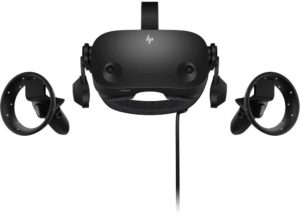 |
HP Reverb G2 |
|
Check on Amazon |
 |
Oculus Rift S |
|
Check on Amazon |
VR 101: All Your VR Questions Answered!
Many people get confused by the sheer number of platforms available when browsing for a VR headset. Worry not, we are here to help you make sense of things!
Here’s a quick breakdown:
HTC Vive and Oculus Rift – are two high-end VR experiences that are both used for PC VR gaming, and both are jaw-droppingly fun. Both systems include headsets, a variety of controllers, and sensors that track your movements. If you’re an avid PC gamer or you want the best possible virtual reality experience, you should definitely go for one of these.
PlayStation VR – is an alternative to the Oculus Rift and HTC Vive. This VR headset requires a PlayStation 4 or a PlayStation 4 Pro. The hardware specs on this VR system aren’t quite as high as the HTC Vive and Rift, but it still offers a decent VR experience. Because this is a Sony licensed system, you won’t encounter many bad VR games. If you ever get a chance, we recommend you try Resident Evil 7 in VR. It’s an incredibly immersive and terrifying experience.
Samsung Gear VR – is a smartphone-based system. There is a plethora of these kinds of systems, and most of them are more gimmicks than legitimate VR experiences- we are looking at you Google Cardboard. Unlike other mobile VR systems, Samsung Gear utilizes Oculus technology to deliver one of the best experiences in its class. Of course, to use Samsung Gear VR, you have to own one of the latest Samsung smartphones.
Microsoft Mixed Reality – is the virtual reality system that just recently hit the market. It’s Microsoft’s attempt to take a place on the VR market. We will tell you more about Microsoft Mixed Reality later in the article.
Microsoft Mixed Reality, you say? Does that mean Xbox is finally getting a VR system?
Well, not exactly. Even though Xbox has been designed with VR in mind, developers were focusing on augmented reality system. A system that is still in development, and will remain in development until the new generation of consoles hit the market.
Does my PC need to be VR-Ready?
The answer to this question is yes. Both the HTC Vive and Oculus RIft require some serious hardware to be able to work without a hitch.
You have a couple of options when it comes to a VR-ready PC. You can either build a VR-ready PC yourself with parts you bought individually. Or, you can buy a prebuilt PC from companies such as Alienware or Origin. You can also go for a VR-ready laptop, but we advise against it because laptops simply can’t compare with desktop PCs, no matter how powerful they are.
If you’re a Mac user, we have some bad news. VR is exclusive to PC.
So I need a decent PC to play VR games. What are the recommended hardware specs?
To make things simple, and not to bore you to death with a dozen different specs, we’re just going to give you two recommended specs, so you have a basic understanding of what kind of rig you need.
Since HTC Vive and Oculus Rift are reigning kings of VR gaming, we’re going to list their recommended requirements.
- Oculus rift recommended hardware specs are:
- Processor: Intel i5-4590, AMD FX-4350, or greater.
- Graphics: nVidia GTX 970, AMD R9 290, or greater.
- Memory: 8GB of DDR4 RAM
- Ports: HDMI 1.3, 3x USB 3.0, and one USB 2.0 port
- OS: Windows 7 64-bit or greater
We know we said we won’t bore you with different configurations, but the specs listed above are a bit outdated. First off, we recommend you don’t go for an Intel processor, but for an AMD Ryzen 5 2600. It’s cheaper than Intel, and it doesn’t suffer from a hardware security flaw. A flaw that will be fixed soon, but will impact the performance of all modern Intel processors. Furthermore, instead of nVidia GTX 970, you can either go for a GTX 1070 or 1070 Ti. And if you want to go one step further, you can go for an RTX 2060 or RTX 2070, both cards support nVidia ray-tracing.
Another thing you should consider is doubling the RAM capacity. Windows 10 without any additional processes running tends to take up to 2GB of RAM. If you have Google Chrome running, this number can rise up to 6GB. Add a game on top of it, and you have nothing left. So, to give your PC a bit of breathing room, we recommend you use a machine that has at least 16GB of DDR4 RAM.
Additionally, you can further speed up your PC by installing an SSD drive. It doesn’t matter if it’s a SATA or an NVMe drive, it will give you a couple of extra frames per second.
I got the specs, but will VR make me sick?
Yes and no. Bad VR will make you motion sick. In bad VR experiences, the frame rate will fluctuate like a flickering TV. This constant shift in frame rate is what makes you motion sick. Good VR systems such as Rift and VIve prevent motion sickness by forcing the frame rate to stay at constant 90 frames per second. That’s why you need a powerful rig to use VR systems, so the frame rate can stay at constant and stable 90 FPS. If you get sick in a car airplane, don’t worry, you probably won’t have any problems with a good VR system.
VR systems have lots of sensors. Do I need a big room?
No, but setting up a VR system in a big room can be loads of fun. The Oculus Rift is designed to be used sitting down, while the HTC Vive allows for movement in space measuring 15 by 15 feet.
If you’re limited to space around your desk or living room, don’t worry, you’ll have enough space for most VR systems. Oculus Rift will allow you to move around your entire room in the near future, which opens up a whole world of possibilities.
The movement also depends on the game you’re playing. For instance, racing and flight games will allow you to sit down, while some shooters will require you to move around your room.
If you’re worried about crashing into walls, don’t be. You won’t crash into walls if you don’t really want to. The HTC Vive, for instance, features a “Chaperone” system that detects the space around you. As you move in virtual space, the Vive will render a virtual wall where the real wall is located, so you won’t hurt yourself or the headset.
Can my kids use VR systems?
Just like with any new technology, it’s up to you, the parent, to make decisions on behalf of your children. Most VR systems are approved for children that are 13 or older.
To quote Brendan Iribe, Oculus Rift CEO: “We put a warning on the right when you put it on and the age of 13 was something that made a lot of sense when we became a part of Facebook, their age is 13 as well. And so we just felt ‘let’s start at 13, let’s evolve the technology more, let’s build more confidence, in the health and safety side of it. And eventually, one day, we definitely want to have Oculus for kids, especially for all the educational use of this.”
Can I switch VR systems?
Yes, but to a certain extent. Most games support multiple VR systems. The only difference between the systems are the controllers, accessories, and room tracking equipment. Accessories for one system won’t work for another.
How often do VR systems get upgraded?
While we can’t confirm anything, PC virtual reality systems are flexible enough to be upgraded every year. However, these upgrades won’t be revolutionary, but rather evolutionary. Meaning each year you can expect to see a slightly better version of the old system, controllers, etc.
Also, as game graphics continue to improve, all necessary upgrades will revolve around your computer, not the VR headsets. VR headsets are basically computer screens, so they can only get improvements in that area, they don’t render graphics.
Will VR systems become more affordable?
This is a tricky question. With time and volume, every electronic product becomes cheaper. Also, you don’t have to buy a brand new system, you can always buy a used one. You can also wait for holiday sales like Black Friday and Cyber Monday.
The same is true for PCs. In a year, your PC will lose on its value because hardware manufacturers are introducing new products each year.
Windows Mixed Reality: Everything You Need to Know About The New VR Contender
Microsoft partnered up with several popular PC manufacturers to launch its new line of mixed reality headsets. These headsets are more affordable than Vive and Oculus and are designed to work with integrated graphics.
So, what is mixed reality? Well, mixed, or merged, reality represents a blend of the real and virtual world. Mixed reality is what happens when virtual reality and augmented reality have a baby.
What is Mixed Reality, Really?
In a perfect world, you’d put MR headset on and it would map your position as well as everything else in the room and overlay a hologram onto the physical world that would acknowledge the real world boundaries of physical objects around you such as tables, chairs, sofas. A true mixed reality system would support both AR and VR.
From all this, you’ve probably deduced that reality is a bit different. And you’re completely right. Microsoft’s first generation MR headsets can only display the world of virtual reality. The mixed reality moniker is just a clever marketing ploy.
You could theorize that these headsets can utilize AR because they feature a pair of external sensors, but that is not the case. These sensors provide inside-out personal tracking, which keep track of the motion controller, and the movement of your head. This, unfortunately, means that MR headsets are just regular VR headsets. The only thing that makes them different from competitors is, that they don’t require separate external sensors to track your position.
How Is Mixed Reality Different Than Virtual Reality?
As we mentioned before, Microsoft’s MR headsets can run on integrated graphics. Furthermore, they don’t require external sensors and a ton of setup. Microsoft’s headsets run on 60 FPS or 90 FPS, depending on how they’re connected. If they’re connected to a PC that has only integrated graphics, then the refresh rate is 60 FPS. If they’re connected to a discrete graphics card, their refresh rate bumps up to 90. They are also much cheaper than the competition. On top of all that, they also support voice commands via Microsoft’s Cortana.
The only aspect where the MR system lacks is the games library. Compared to Vive’s or SteamVR’s library, the offering is quite meager. Thankfully, you can play SteamVR games with these headsets, which broadens your options significantly.
MR headsets also have a narrower field of view and lower image quality than their competition. But, when you consider their price, this is a fair tradeoff.
Who Manufactures Mixed Reality Headsets?
Microsoft teamed up with several big league PC manufacturers including Acer, Dell, HP, and Lenovo. Microsoft also teamed up with Samsung to develop the Odyssey headset, the most advanced Mixed Reality headset. This headset features AMOLED displays and integrated audio, courtesy of AKG.
Because Microsoft licensed the production of MR headsets multiple companies, their price varies a lot. The “low-end” models sell for $299, while the “high-end” models go out for $499. Keep in mind that Rift and Vive sell for $399 and $599, respectively. This makes MR headsets an excellent stepping stone into the world of virtual reality. They don’t require as much setup as the competition and offer a similar experience at two-thirds of the price.
Minimum Hardware Specs
To use one of the mixed reality headsets, you need the following specs:
- 6th Generation Core i5 processor, or better
- nVidia GTX Geforce 965M or AMD Radeon RX 460
- 16GB of DDR4 RAM
- One HDMI 2.0 port or DisplayPort 1.2
- One USB 3.0 slot
- Windows 10 Fall Creators Update
The minimum requirements are on par with Vive and Oculus. We do recommend you go for a more recent graphics card and processor.
90 FPS vs 60 FPS
There is a noticeable difference between playing at 90 FPS and 60 FPS. Vive and Rift use 90 FPS to avoid causing motion sickness. While you can run VR games at 60 FPS, the experience isn’t as nearly as smooth as playing at 90 FPS. For example, when we played Space Pirate Trainer and Superhot at 60 FPS with Acer’s AH101 headset, we noticed that the image was choppy and vomit inducing, which is not the case when run at 90 FPS. The graphics were also noticeably less muddy when played at 90 frames per second.
Fortunately, MR headsets only work in 60 FPS when they’re connected to integrated graphics. We do appreciate the idea that even people with less than ideal graphics cards can enjoy the VR experience. However, we recommend you, at least, get a laptop with discrete graphics, so you can enjoy 90 FPS at lower graphics settings.
Microsoft Mixed Reality headsets are an excellent choice for people who want something better than the mobile VR experience they would get from a Samsung Gear VR or Daydream View headset but don’t want to commit a financial suicide for a high-end VR system. While we’re not big fans of the 60 FPS experience, we appreciate the wide array of notebooks the MR headsets can support by virtue of their integrated graphics support.
At the end of the day, Microsoft has a lot of catching up to do with their headsets. Supporting the SteamVR store is an excellent start because it gives people access to a huge selection of games. However, the displays in the headset have room for improvement and so does the field of view. We have very high hopes for this system and we’re looking forward to seeing what Microsoft will do to improve it.
6 Best VR Headsets for PC Gaming
Now that you’re familiar with VR headsets for PC gaming, you can take a look at our top picks. We gave our best at showcasing products from all price ranges and a variety of manufacturers.
1. Oculus Rift
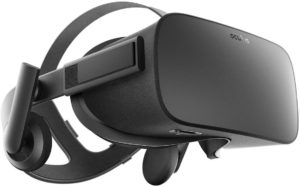
We can’t help but start the list with the absolute king of VR headsets, the Oculus Rift. After a long period of being viewed as cool but janky technology, this headset is what reignited the interest in VR. The Oculus Rift is by far the most polished headset on the market today. It perfectly demonstrates how far VR technology has come.
Let’s go over the specs. Oculus Rift runs at 1080p resolution with a refresh rate of 90 frames per second. The resolution of this headset is one of the main gripes we have with it. Playing hectic games like Doom VR or Beat Saber is awesome, but the story is very different when it comes to racing or flight simulations. When playing simulators, especially flight simulators, you will soon discover that you can’t read the dials due to them being muddy and pixelated. It’s a real shame too, because this headset features 110 degrees of FOV, making it perfect for all types of immersive simulators. We hope that the next generation of these headsets will run on a higher resolution.
Thankfully, everything else on this headset is absolutely perfect. The Rift doesn’t require a high-end graphics card to work. The games will run perfectly smooth on, now severely outdated, Nvidia GTX 960 or GTX 1050 Ti. This is all possible thanks to the Oculus’ proprietary Asynchronous Spacewarp technology.
Where this headset really shines is in the controller department. The Oculus utilizes touch controllers that are incredibly comfortable, with buttons and analog sticks positioned in a way that allows your hands to be in a relaxed fixed position. This allows for actions such as grabbing items or holding weapons to feel fluid and natural.
Comfort-wise, the Oculus Rift is one of the best headsets on the market. You put it on your head just like you would a baseball cap, by putting over the back of your head and then pulling it over your eyes. The three straps distribute weight evenly, so you don’t feel like your nose is bearing its full weight. The faceplate is padded with a soft cushion-like material that adheres to your face tightly, a bit too tightly if you ask us. This headset is notoriously uncomfortable for people who wear eyeglasses.
Pros
- Pioneers in the VR field
- Superb motion controllers
Cons
- Uncomfortable to wear with eyeglasses
- The resolution leaves a lot to be desired
Bottom Line
If you want to experience the best possible VR experience without having to upgrade your PC and clear out half of your room for additional sensors, the Oculus Rift is a perfect choice for you. We especially recommend it if you’re an avid PC gamer because Vive store is the biggest VR game library to date, and it also supports SteamVR.
2. HTC Vive
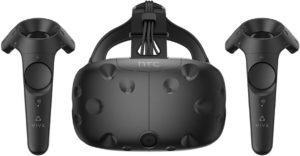
The biggest contender to the throne of the king of VR headsets is the HTC Vive. Unlike Oculus Rift, which allows for only limited movement, the HTC Vive supports room-scale tracking out of the box and also comes with motion controllers that allow full immersion no matter what game you’re playing.
The bread and butter of this headset are its room tracking capabilities. Thanks to its two external motion sensors, you will be able to move around in a space measuring 4.5 by 4.5 meters. Being able to move around introduces a whole new level of immersion, allowing you to affect the virtual world not only with the motion controllers but with the movement of your body too. The controllers are not as good as those on the Oculus Rift. The touchpad on Vive’s motion controller is awkwardly placed and will cause strain in your wrist after a long game session. Other than that, the controllers are miles better than anything else on the market.
The HTC Vive VR headset utilizes two 1080p displays that produce a nice and crisp image. Unfortunately, this VR headset suffers from the same issues as the Oculus Rift, that being the muddy image in some games. If you decide to play simulations with this headset, you will have a hard time reading dials on the dashboard of the car/plane/spacecraft. The HTC Vive Pro addresses this issue thanks to its 78% increase in DPI, but its price tag is out of range to many consumers.
Comfort-wise, we have nothing but words of praise. The headset distributes the weight evenly over the head, allowing for lengthy game sessions without any strain on the neck or nose. The HTC Vive utilizes Velcro straps that are fully adjustable for most head sizes and has ample space for eyeglasses (with only minor discomfort).
Pros
- The second best VR experience on the market
- Supports SteamVR
- Allows for movement in the real world, further increasing immersion
- Very comfortable to wear
Cons
- Requires a fairly competent PC rig in order to work smoothly
- The displays muddy the graphics in certain games
Bottom Line
If you’re looking for a VR headset that will provide you with the best possible immersion at the expense of smaller game library, then the HTC Vive is a perfect choice for you. Even though it’s more expensive than the Oculus Rift, it offers the best bang for the buck compared to the Pro version that has its shortcomings that doesn’t justify the high price tag.
3. Samsung Odyssey
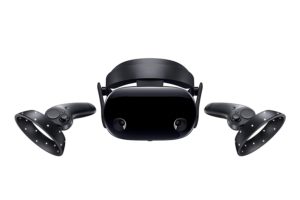
When Windows announced their Mixed Reality system, no one was really surprised. What did surprise everyone is their partnership with Samsung to create a flagship VR headset. Samsung HMD Odyssey offers a jaw-dropping joyride into the world of virtual reality in the Windows 10 ecosystem.
When it comes to design, the Odyssey doesn’t stick out in any particular way. It’s black, with no color accents at all bearing a resemblance to LG SteamVR headset showcase at GDC back in 2017. The headset has a somewhat budget feel to it, which is mostly caused by its low weight and the cheap feeling plastic. However, this is just a first impression. Upon further inspection, we concluded that it wasn’t poorly made or flimsy. Quite the contrary, the assembly is excellent, and the headset is very comfortable to wear.
This VR headset features built-in AKG headphones that slide down and offer excellent sound quality. Not only that, but it has excellent surround capabilities, allowing for an incredibly immersive experience. It also features an inbuilt microphone array, eliminating the need for an external microphone and reducing the mess of cables running from your computer.
Where the Odyssey really shines is its dual AMOLED displays. The screens sport a resolution of 1440 by 1600 pixels per side and a refresh rate between 60 and 90 FPS, depending on how it’s connected to the computer. The visuals are buttery smooth with noticeably vivid colors. The AMOLED technology Samsung is known for on its Galaxy phones is what makes this model a flagship model in the MR product line.
Microsoft’s motion controllers, that this headset comes with, although as not as intuitive as controllers from Oculus or Vive, are perfectly fine. You can always switch the motion controllers for an Xbox controller, or with a mouse and keyboard combo.
The biggest benefit this VR headset provides is the inside-out movement tracking. You don’t have to set up external sensors, further cluttering your room with cables. The only thing that could be improved is a system that will notify you when you’re approaching an obstacle in the real world.
Pros
- Superb AMOLED displays Samsungs is known for
- Can work with computers that have only integrated graphics
- Cheaper than Oculus and Vive
- Supports SteamVR
Cons
- The Odyssey feels cheap
- Motion controllers are not as good as the ones from Oculus and Vive
Bottom Line
If you’re looking for a VR headset that doesn’t require a ton of setup and has better visual fidelity than Oculus or Rift, then Samsung HMD Odyssey is a perfect choice for you. Even though it feels cheap, the AMOLED displays, inbuilt headphones and microphone array, are well worth the investment.
4. Lenovo Explorer
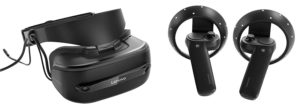
Microsoft’s partnership with hardware manufacturing giants really shook the VR world. The headsets suddenly became more affordable and accessible. The Lenovo Explorer MR headset is a perfect example of this, with its competitive pricing and more than serviceable graphical fidelity.
Despite its low price, Lenovo Explorer looks really good. Its all black design doesn’t look as cheap as Odyssey’s. The headset is light enough to ensure you won’t feel any discomfort even during long game sessions. You can adjust the headset to your head size by twisting a large dial at the back, which is a much easier method than adjustable Velcro straps of the HTC Vive. Another excellent design choice is the ability to lift the visor up, allowing you to see the real world without the need to take the whole headset off. Quite handy when you want a quick break from the VR world.
To track your head and body movement, the Lenovo Explorer uses two motion-tracking cameras, a gyroscope, and an accelerometer. The tracking is on par with Rift and Vive, and we haven’t encountered any issues with it during our test.
To bring the world of VR to your eyes, the Explorer utilizes two 2.89-inch and a pair of LCD displays with a combined resolution of 2880 by 1440 pixels. In theory, the resolution offered by this headset is better than Vive’s 2160 by 1600, however this is only a marginal improvement because individual displays only offer a resolution of 1440 by 1440 pixels. We also noticed that the image is visibly blurry along the edges of the lenses ruining the immersion.
Along with the MR headset, you also get two motion controllers. The controllers are standard amongst all MR headsets and are perfectly serviceable. They respond well to input and, just like with all MR headsets, work in pair with the internal sensors to track the movement of your hands. They are a bit uncomfortable because they place your thumb in an awkward position, which causes strain in wrists after a while.
Pros
- Affordable
- Comes with two motion controllers
- Very comfortable to wear
Cons
- The smaller lenses significantly reduce the immersion
- The LCD screens leave a lot to be desired
Bottom Line
The Lenovo Explorer MR headset is an excellent choice for those who are on a tight budget but still want to enjoy a decent VR experience. It isn’t breaking any new ground, it just works. You won’t find a better VR experience at this price point, that’s for sure.
5. HP Reverb G2

This product was designed by Microsoft and Valve. This VR headset provides an immersive, comfortable, and compatible experience. This VR headset has an interpupillary distance adjustment feature. This feature allows you to adapt the width of the lenses for different eye distances.
This VR headset has four inbuilt cameras that allow you to track movement over its predecessor. The controllers are also comfortable to hold. Item weight is 1.1 pounds, while it has a resolution of 4320 × 2160.
This product is easy and comfortable to set up. What sets this product apart from others is the high-resolution lenses. The immersion experience this product provides is second to none. The standard of design makes the product attractive.
It has built-in headphones, the headset itself can be adjusted for comfort. All you have to do is to adjust the velcro belt. This product needs a high-power PC to function, the reason being that it has high-resolution lenses. The only downside we noticed is that you can’t connect it wirelessly to a PC.
Pros
- High-resolution lenses: the immersion experience is superb, it abolishes any form of screen door effect
- Easy to set up: it takes up to 30 minutes or less to assemble
- Relatively cheap: though the product is not the cheapest headset you’d find in the tech market, it is cheaper than HTC Vive Cosmos and HTC Vive Pro
Cons
- Cable gets in the way when not in use
- Motion tracking is devoid of precision
Bottom line
The HP Reverb G2 offers great value for money. It is one of the best VR headsets out there. The high-resolution lenses set it apart from the rest. It offers a great immersive experience. The lenses assist in abolishing the screen door effects. It is highly recommended by our team.
6. Oculus Rift S
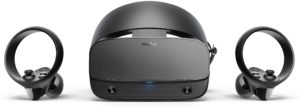
The Oculus Rift S represents the absolute pinnacle of what a first generation VR headset can provide. It’s an upgrade to the original Oculus in almost all aspects. We placed it last on our list because it still hasn’t hit the market, but you can preorder it.
Design-wise, the Rift S stands out from the old model in two aspects. The first being that it no longer requires external sensors to track your movement, but rather uses inside-out movement tracking pioneered by Microsoft. The second aspect where the Oculus S differs from the other models is the wire that connects to your PC. Unfortunately, we’ll have to get used to wires running from our computer in order to enjoy the best possible VR experience.
Another thing where the Oculus S differs from the original Oculus is the way you put it on. Oculus ditched the old tri-strap system for a more comfortable halo shape headband that you can adjust by turning a large dial located at the back. This is a massive improvement and will save you a lot of time finicking with the straps so the headset sits comfortably on your head.
Besides the improvements in ergonomics and the way it tracks your movement, the Oculus Rift S will feature better displays. Namely, a new fast-switch LCD screen, a 2560 by 1440 pixel resolution display. The lenses are also improved and will be less reflective than the lenses on the original Rift.
The only downside to all this is the refresh rate. The Rift S will run at 80 frames per second, rather than at 90 frames per second. According to the guys at Oculus, this change was made for the sake of developers who apparently now have an easier target to hit and keep a level performance across a platitude of devices.
Pros
- Comfortable and easily adjustable
- Superb visual quality
- An overall improvement to the original Oculus Rift
Cons
- We don’t know how will the change to 80 FPS affect the games and the experience
Bottom Line
If you’re willing to wait a couple of months for an improved version of the Oculus Rift, then go to the Amazon pre-order page and click on that add to cart button now! We have no doubt that this headset will offer the best possible VR experience once it hits the market.
What do you think about VR gaming on PC? Is it worth the investment? Do you own any of the headsets showcased above? Let us know in the comments below!
YOU MIGHT ALSO LIKE:
Best VR Headsets You Can Buy Today
Best 3D Glasses Your Eyes Will Thank You For


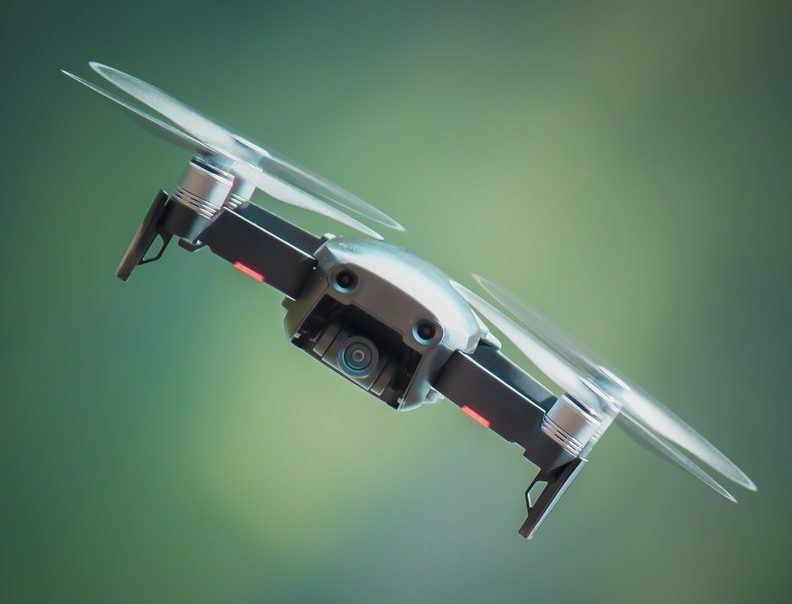


No Responses